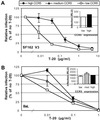Sensitivity of HIV-1 to entry inhibitors correlates with envelope/coreceptor affinity, receptor density, and fusion kinetics
- PMID: 12444251
- PMCID: PMC138597
- DOI: 10.1073/pnas.252469399
Sensitivity of HIV-1 to entry inhibitors correlates with envelope/coreceptor affinity, receptor density, and fusion kinetics
Abstract
HIV entry inhibitors include coreceptor antagonists and the fusion inhibitor T-20. T-20 binds the first helical region (HR1) in the gp41 subunit of the viral envelope (Env) protein and prevents conformational changes required for membrane fusion. HR1 appears to become accessible to T-20 after Env binds CD4, whereas coreceptor binding is thought to induce the final conformational changes that lead to membrane fusion. Thus, T-20 binds to a structural intermediate of the fusion process. Primary viruses exhibit considerable variability in T-20 sensitivity, and determinants outside of HR1 can affect sensitivity by unknown mechanisms. We studied chimeric Env proteins containing different V3 loop sequences and found that gp120coreceptor affinity correlated with T-20 and coreceptor antagonist sensitivity, with greater affinity resulting in increased resistance to both classes of entry inhibitors. Enhanced affinity resulted in more rapid fusion kinetics, reducing the time during which Env is sensitive to T-20. Reduced coreceptor expression levels also delayed fusion kinetics and enhanced virus sensitivity to T-20, whereas increased coreceptor levels had the opposite effect. A single amino acid change (K421D) in the bridging sheet region of the primary virus strain YU2 reduced affinity for CCR5 and increased T-20 sensitivity by about 30-fold. Thus, mutations in Env that affect receptor engagement and membrane fusion rates can alter entry inhibitor sensitivity. Because coreceptor expression levels are typically limiting in vivo, individuals who express lower coreceptor levels may respond more favorably to entry inhibitors such as T-20, whose effectiveness we show depends in part on fusion kinetics.
Figures






Similar articles
-
Kinetic factors control efficiencies of cell entry, efficacies of entry inhibitors, and mechanisms of adaptation of human immunodeficiency virus.J Virol. 2005 Apr;79(7):4347-56. doi: 10.1128/JVI.79.7.4347-4356.2005. J Virol. 2005. PMID: 15767435 Free PMC article.
-
Sensitivity of human immunodeficiency virus type 1 to fusion inhibitors targeted to the gp41 first heptad repeat involves distinct regions of gp41 and is consistently modulated by gp120 interactions with the coreceptor.J Virol. 2001 Sep;75(18):8605-14. doi: 10.1128/jvi.75.18.8605-8614.2001. J Virol. 2001. PMID: 11507206 Free PMC article.
-
Impact of mutations in the coreceptor binding site on human immunodeficiency virus type 1 fusion, infection, and entry inhibitor sensitivity.J Virol. 2004 May;78(10):5476-85. doi: 10.1128/jvi.78.10.5476-5485.2004. J Virol. 2004. PMID: 15113926 Free PMC article.
-
HIV entry inhibitors: mechanisms of action and resistance pathways.J Antimicrob Chemother. 2006 Apr;57(4):619-27. doi: 10.1093/jac/dkl027. Epub 2006 Feb 7. J Antimicrob Chemother. 2006. PMID: 16464888 Review.
-
Progress in targeting HIV-1 entry.Drug Discov Today. 2005 Aug 15;10(16):1085-94. doi: 10.1016/S1359-6446(05)03550-6. Drug Discov Today. 2005. PMID: 16182193 Review.
Cited by
-
HIV-1 resistance to maraviroc conferred by a CD4 binding site mutation in the envelope glycoprotein gp120.J Virol. 2013 Jan;87(2):923-34. doi: 10.1128/JVI.01863-12. Epub 2012 Nov 7. J Virol. 2013. PMID: 23135713 Free PMC article.
-
The HR2 polymorphism N140I in the HIV-1 gp41 combined with the HR1 V38A mutation is associated with a less cytopathic phenotype.Retrovirology. 2012 Feb 14;9:15. doi: 10.1186/1742-4690-9-15. Retrovirology. 2012. PMID: 22333046 Free PMC article.
-
Covalent stabilization of coiled coils of the HIV gp41 N region yields extremely potent and broad inhibitors of viral infection.Proc Natl Acad Sci U S A. 2005 Sep 6;102(36):12903-8. doi: 10.1073/pnas.0502449102. Epub 2005 Aug 29. Proc Natl Acad Sci U S A. 2005. PMID: 16129831 Free PMC article.
-
Replication-competent variants of human immunodeficiency virus type 2 lacking the V3 loop exhibit resistance to chemokine receptor antagonists.J Virol. 2007 Sep;81(18):9956-66. doi: 10.1128/JVI.00385-07. Epub 2007 Jul 3. J Virol. 2007. PMID: 17609282 Free PMC article.
-
Characterization of HIV-1 envelope gp41 genetic diversity and functional domains following perinatal transmission.Retrovirology. 2006 Jul 4;3:42. doi: 10.1186/1742-4690-3-42. Retrovirology. 2006. PMID: 16820061 Free PMC article.
References
-
- Trkola A., Dragic, T., Arthos, J., Binley, J. M., Olson, W. C., Allaway, G. P., Cheng-Meyer, C., Robinson, J., Maddon, P. J. & Moore, J. P. (1996) Nature 384, 184-187. - PubMed
-
- Wu L., Gerard, N. P., Wyatt, R., Choe, H., Parolin, C., Ruffing, N., Borsetti, A., Cardoso, A. A., Desjardin, E., Newman, W., et al. (1996) Nature 384, 179-183. - PubMed
Publication types
MeSH terms
Substances
Grants and funding
LinkOut - more resources
Full Text Sources
Other Literature Sources
Medical
Research Materials

